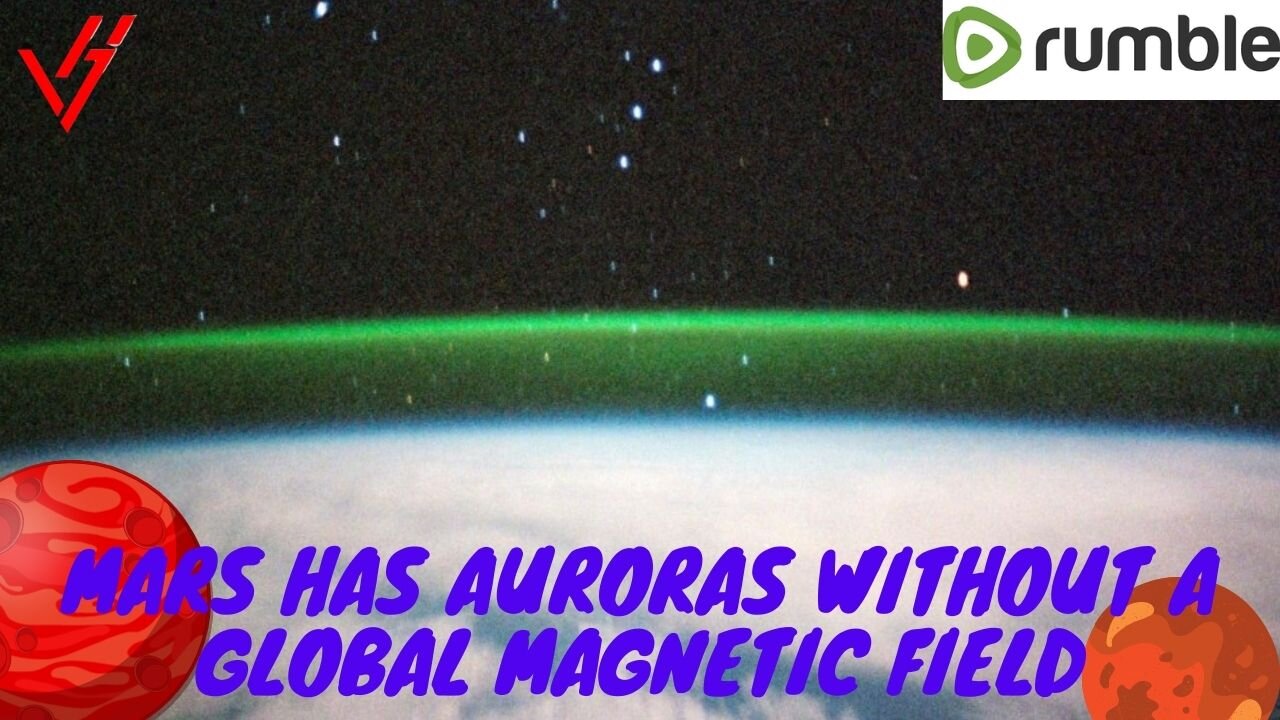Premium Only Content

Mars has auroras without a global magnetic field
00:00 - Mars has auroras without a global magnetic field
Earth's auroras are a glorious wonder, but our planet isn't the only place in the Solar System where these phenomena can be found.
An atmospheric glow, albeit sometimes in invisible wavelengths, has been spotted at every planet except Mercury, and even some moons of Jupiter... and even a comet. But Mars is where it gets interesting. The red planet is famous for its lost global magnetic field, an ingredient that plays a crucial role in the formation of aurora elsewhere.
00:42 - 1 - Study:
But that doesn't mean Mars is totally magnetism-free. Regions of localized magnetic fields sprout from some regions of the crust, particularly in the southern hemisphere. New analysis has confirmed that these small, local magnetic fields interact with the solar wind in interesting ways to produce Mars's discrete (or structured) ultraviolet auroras.
"We have the first detailed study looking at how solar wind conditions affect auroras on Mars," said physicist and astronomer Zachary Girazian of the University of Iowa.
"Our main finding is that inside the strong crustal field region, the aurora occurrence rate depends mostly on the orientation of the solar wind magnetic field, while outside the strong crustal field region, the occurrence rate depends mostly on the solar wind dynamic pressure."
Here on Earth, we have a pretty good handle of how auroras – borealis and australis – happen. They appear when particles from the solar wind collide with Earth's magnetosphere, and are then accelerated along the lines of the magnetic field to high latitudes, where they rain down into the upper atmosphere.
There, they interact with atmospheric particles to produce the shimmering lights that dance across the sky.
01:54 - 2 - Evidence:
Evidence suggests that the phenomena form in similar ways on other bodies. For instance, Jupiter's powerful, permanent auroras are also facilitated by the enormous planet's complex magnetic field.
But Mars's global magnetic field decayed fairly early on in the planet's history, leaving behind only patches of magnetism preserved in magnetized minerals in the crust. Ultraviolet images of Mars at night have revealed that auroras tend to form near these crustal magnetic fields, which makes sense if magnetic field lines are required for particle acceleration.
Girazian and his team's work also takes into account the solar wind conditions. They analyzed data from the Mars Atmosphere and Volatile EvolutioN (MAVEN) spacecraft, which has been collecting ultraviolet images of the red planet since 2014. It's also equipped with an instrument called the Solar Wind Ion Analyzer, which, unsurprisingly, analyzes the solar wind.
They compared data on the dynamic pressure of the solar wind, as well as the strength and angle of the interplanetary magnetic field, with ultraviolet data on the Martian auroras. They found that, outside the crustal magnetic field regions, the dynamic pressure of the solar wind plays a significant role in the detection frequency of auroras.
03:11 - 3 - Weather events:
However, the pressure of the solar wind seems to play little role in the brightness of said auroras. This suggests that space weather events, such as coronal mass ejections, where masses of charged particles are ejected from the Sun and are associated with higher solar wind pressure, may trigger Martian auroras.
Inside the crustal magnetic field regions, the orientation of the magnetic field and the solar wind seems to play a significant role in the formation of auroras on Mars. At certain orientations, the solar wind seems to be favorable to the magnetic reconnection events or particle acceleration required to produce the ultraviolet glow.
These results, the researchers said, reveal new information on how interactions with the solar wind can generate auroras on a planet stripped of its global magnetic field. This information can be used to help better understand the formation of discrete auroras on very different worlds.
"Now is a very fruitful and exciting time for researching aurora at Mars,"
Research: Vitor hugo Lizardi Leonardi
About my channel of curiosities, this channel is to see and hear curiosities of our world in general, if possible leave your like and subscribe to have new notifications about new subjects, thank you very much
Come meet me, and give your opinion about the channel, for me it's very important!
—— ?? TALK TO ME.
Research: Vitor hugo Lizardi Leonardi
facebook: facebook.com/vitor.leonardi
instagran: instagram.com/vitorleonardi/
twitter: twitter.com/vitorleonardi
email: vitorleonardi99gmail.com
Crédito da música: Somewhere Over the Rainbow {O Mágico de Oz}
Interpretada: Shirless Violinist
Composição: Haroid Arien
Produzido: Shirless Vilinist
Fonte: TSV Entertainment
Good reading ,The 7 Habits of Highly Effective People
https://www.amazon.com.br/Habits-Highly-Effective-People-Powerful/dp/1982137274/ref=asc_df_1982137274/?tag=googleshopp00-20&linkCode=df0&hvadid=379726347250&hvpos=&hvnetw=g&hvrand=6784634493429849819&hvpone=&hvptwo=&hvqmt=&hvdev=c&hvdvcmdl=&hvlocint=&hvlocphy=20104&hvtargid=pla-908915591470&psc=1
Hello friends, If you liked it, don't forget to LIKE and SUBSCRIBE to the channel, strengthen our work, it's very important, to expand the channel. I'll tell you, thank you
The channel was created to promote texts and sounds for us to think a little about life and how we can be very happy with the little we have, liked it, leave your LIKE, your comment as soon as possible, we will respond, thank you.
I'm a writer, I'm working on this project!
contact we will respond within 48 hours ??? email: [email protected]
#mars, mars auroras, magnetic field,#earth,#planet, #phenomena,#glow, #jupter,#mercury, #red planet,#aurora formation, #magnetic,#solar system,#vitorleonardi
-
 LIVE
LIVE
The Trish Regan Show
32 minutes agoBREAKING: NFL Picks Anti-Trump Rapper Bad Bunny for Super Bowl—Risking MASSIVE Fan Boycott!
1,008 watching -
 45:18
45:18
Stephen Gardner
1 hour ago🚨EXPOSED: Real reason Trump preparing for war - Tulsi Gabbard WARNS Trump!!
2.67K13 -
 4:23:04
4:23:04
Right Side Broadcasting Network
7 hours agoLIVE REPLAY: President Trump Participates in a Press Conference With Prime Minister Netanyahu - 9/29/25
66.8K29 -
 1:09:19
1:09:19
The White House
4 hours agoPresident Trump Participates in a Bilateral Meeting with the Prime Minister of the State of Israel
11.6K25 -
 1:25:35
1:25:35
Russell Brand
3 hours agoMichigan Church Shooting Sparks Trump Warning Of ‘TARGETED ATTACK On Christians’ - SF641
151K43 -
 1:59:24
1:59:24
The Charlie Kirk Show
3 hours agoRemembering Charlie's Martyrdom and Continuing His Revival | Driscoll, McPherson | 9.29.2025
172K43 -
 1:34:24
1:34:24
Sean Unpaved
3 hours agoEuropeans Too Good, Lamar's Limp-Off, & the MLB's Playoff Party: Weekend Sports Review
30K4 -
 1:15:02
1:15:02
Mark Kaye
4 hours ago🔴 TRUMP Furious Over Bad Bunny Super Bowl Halftime Show
31.8K3 -
 46:58
46:58
MattMorseTV
4 hours ago $10.07 earned🔴COURT DATE for Kirk's ASSASSIN.🔴
59K29 -
 2:11:40
2:11:40
Nerdrotic
4 hours ago $3.67 earnedOne Woke After Another | JK Rowling NUKES Emma Watson - Nerdrotic Nooner 520
58.9K8